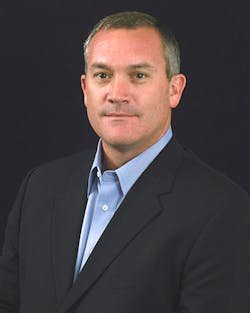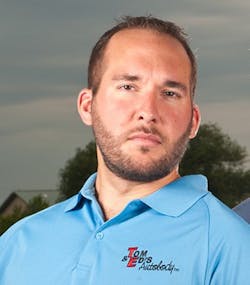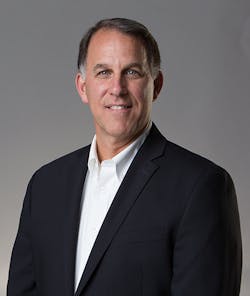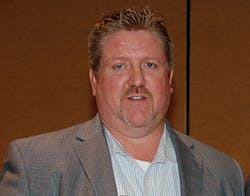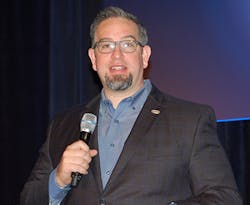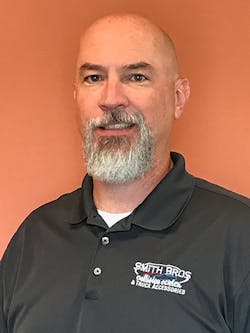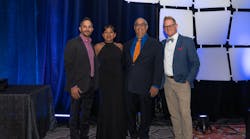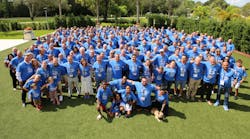What are the challenges facing multi-shop operators? How are they attracting and retaining the new, younger employees they need? How do they see the industry evolving?
Once again this year, ABRN convened an “MSO Roundtable,” bringing together a panel (see sidebar, “Who was at the table?”) to discuss some of these topics. Here are highlights from the discussion (responses were edited for length or clarity).
| Who was at the table? |
|
Dean Fisher is the chief operating officer for CARSTAR in North America, and a former owner of CARSTAR shops. Paul Gange is the president and chief operating officer for Fix Auto USA. Darren Huggins is national collision director for Berkshire Hathaway Automotive, which operates more than 30 dealership body shops. Aaron Schulenburg is the executive director of the Society of Collision Repair Specialists (SCRS). Chad Smith is co-owner of Smith Bros. Collision Centers, which operates three shops in Mississippi. Andy Tylka is a second-generation owner of Tom and Ed’s Autobody, which has five locations in Northwest Indiana. |
ABRN: What would you say is the biggest challenge facing your organization in the next 12-24 months, and how are you addressing it?
Paul Gange: As we look out at the next 12 to 24 months, I think we find ourselves in a bit of a convergence. An industry we’ve worked in for many years is seeing new entrants, in terms of influencers – specifically the OEMs, but also others, folks that are beginning to assess quality of repairs, for example. So we’re investing a considerable amount of our time and resources into tooling and training, and into developing strategies for working more closely with those types of entities. While quality repairs have always been important, I don't think they’ve ever been more important than they are today. Ensuring consistency from repair to repair is of the utmost importance for us. The risk [of not doing so] is just too high.
Andy Tylka: We aren’t as much DRP-driven as dealership-driven. Before, the customer would call the dealership and the vehicle would just get sent to us. That’s not the case any more. The dealerships are being required to send vehicles to OEM certified shops. We were behind the eight ball. We took ourselves off of I-CAR [Gold Class] maybe eight years ago. We’re back on that program. We’re scrambling to get our certifications. That’s our biggest challenge right now.
Chad Smith: With the advancement of technology and ADAS, we’re trying to consistently focus on repair planning and disassembly, but we were trying to do it with the same number of people. That won’t work. You’re going to have to grow your front office staff in order to properly predicate the repair with the correct procedures and information to move through production. We’re looking at hiring more administrative people, one per location, just to serve as a repair planner and to do all the research.
Dean Fisher: We’re really focused on the consolidation process that’s taking place. We feel that’s going to change the landscape to some degree. For CARSTAR, our concern is high-level growth. Adding 100 or 200 shops on an annual basis is a great opportunity, but how do you maintain the culture and the quality? Controlling the outcome of your facilities, whether you own them or whether you’re on the franchise side, is important. What that looks like to the consumer, the insurers, and the OEMs is a real important concern of ours.
Aaron Schulenburg: Several of the others talked about the human resources aspect, and I think for us, that workforce development piece is really important for our members. Size and scope affords [larger companies] some opportunities to do some [workforce] development work that’s harder for some other folks. We want to make sure whether it’s a small business or a large business, there’s an opportunity to draw people into our industry and give them a good career and advancement path. So we’re working on things like 401(k) plans and trying to find the right solutions around health care, things that are going to help the industry grow and pull in some of the younger generation.
ABRN: Speaking of young people, what have your found most effective in attracting, motivating and retaining workers in the 20-35 age range?
Darren Huggins: We’re having to get a little creative, having to be a little bit more ‘user-friendly’ for employees. Before, it was: ‘We open at 7 a.m., and we go until 6 p.m., and you get an hour for lunch and so much for a break twice a day, but other than that, we need you at work.’ Now we’re having to be a little bit more flexible. We’re also finding that, depending on demographics, a lot of kids getting out of high school just need a job. They’re not saying, ‘I’ve got to go to school and I need this degree.’ They are saying, ‘I need to go to work.’ So we’re really focusing on the mentorship piece, seeing if we can help some of these students that really need to get into work right away get a career started. We’re having some success with that.
Gange: I think that, collectively, we still think we’re the same industry we were. It’s a different industry today. We all lament that [young people] want to work for companies like Apple or get into artificial intelligence or gaming or some sort of technology company. They’re not generally looking to pound dents out of the side of a car. But our industry has changed so much. There are positions in our shops now that didn’t exist two or three or five years ago, positions that, if we marketed them properly, compete very well with companies in Silicon Valley. Scanning technicians, people responsible for calibrating vehicles, those deeply involved in the way the computer systems in our vehicles work. In the front office, we have positions for people who are focused on social media management, and different types of marketing roles like that. If we start thinking that way, I think we’ll find we can attract those in their 20s and 30s. And you know what? Their friends may be the car guys like Darren was talking about who want to get their hands dirty and go to work right away.
Schulenberg: I think for a younger generation, the new technology presents growth opportunities that allow for less static experiences within the business. Some of the shops that I think are really successful provide their employees opportunities to grow and tackle other tasks, even if those tasks are outside their initial core responsibilities. It gives the shop a little more experience on the bench, but also gives employees the ability to feel like they are doing something new regularly, developing new skills sets.
Tylka: One thing we do well is recruitment and internal training, and we’re always recruiting. We’ve not just recruiting when we need somebody. We’re doing that 12 months out of the year. We interview everybody. Even if we don’t need a painter, we’ll still interview a painter because ‘car guys and gals’ hang out with other ‘car guys and gals.’ That painter might know a technician or an apprentice who we might be able to integrate into our company. We’re also putting more entry-level people into the new positions like those doing the [repair] research and the scanning and checking-in the vehicle before we even pick up a tool. Those are becoming full-time positions. We can bring in a younger generation to do that work, and then train them into a body tech or estimator. We notice with these younger people, we need to have a career path for them. We tell them, ‘These are the goals you need to accomplish,’ and we regularly have meetings with them to see where they are on their goals. They want that constant feedback and clear career paths to get to where they want to be. It’s working out really well for us.
ABRN: What changes do you see happening now – or soon – in the relationships and interactions among automakers, insurers, shops and consumers?
Fisher: We think the insurers are embracing the OEMs a little bit more. I think they understand the OEMs will be in a position to control first notice of loss. It leads us to wonder: How much are they going to integrate into the claims handling process? What is that going to look like? They want the customer to stay in a GM car or a Ford car or a Chrysler car or whatever it is. They want them to go to a certified collision center. They want the vehicle repaired in a safe manner and returned properly to the street. They recognize there’s migration from a brand if a customer has an accident and the vehicle is not repaired properly in a timely manner. I think the insurers will embrace that process to some degree.
| Predictions, predictions |
|
ABRN MSO Roundtable participants were asked what they foresee happening in terms of the size of the U.S. shop population, and when they see individual consumers being able to buy “Level 5” fully autonomous vehicles. None think the total number of shops (rooftops) will be higher five years from now, in 2024. Aaron Schulenburg said he foresees little or no change, or at least less than a 5% drop. The others think there will be more of a decline, including predictions of a drop of 10% or more by Darren Huggins, Andy Tylka and Dean Fisher. “Vehicle technology, and the cost of doing business will be the key factors,” Fisher said. There was a wider spread in when they think fully autonomous vehicles will be sold to consumers at U.S. dealerships. Chad Smith thinks such vehicles will be in some markets in the next 5-7 years, and Tylka foresees them in consumer’s hands before 2030, with politics and public concerns slowing the process down more than technology. The others don’t see it happening before 2030. Fisher said it will require a full-scale 5G network to accommodate geopositioning. Huggins thinks technology issues will push it even further out, at least 20 years from now. “The OEMs have a long way to go,” he said. |
Schulenberg: There’s often been this challenging dynamic between the insurer and the repairer. While their objectives should kind of line up, sometimes mitigating claims costs gets in the way of the shop’s objective to be profitable. I think you’re seeing the OEMs creating a triangle [with shops and insurers] versus just than the dynamic back and forth between insurers and shops. But at the end of the day, I think we should all be focused on performing the right repair, putting people back on the roadways safely. There’s a lot of alignment between the repairers and the OEMs, especially relative to procedures. But I struggle with the fact that there’s still a big discrepancy in finding mutual acceptance [by insurers] of repair procedures and repair approach. I still don’t feel like we’re on the same page. You still have folks who are arguing that repair procedures are ‘case-by-case.’
Smith: I think Aaron nailed it. Also as a shop, you need to look at why do you want to achieve OEM certification? I would love to see the automakers get more involved because they could drive the conversation from the first notice of loss forward based on who is certified. But nobody knows that at this point. There’s no guarantee the OEMs are going to [do that]. So from a shop standpoint, why should we go after shop certification? We do that for a couple of reasons. One, we use it as a marketing tool. We let the customer know what it means to them. But secondly, it’s our responsibility to properly repair these vehicles. How can you properly repair them if you don’t have the training and the access to proper information to do so? [The certification programs] aren’t perfect at this point by any means, but that’s all we’ve got. How else can you sell to the customer that you’re going to properly repair that vehicle?
Higgins: Let’s face it, that first notice of loss, when telematics become full-blown and the certified shop gets notice before the [insurance] carrier does, is going to change the game dramatically. If you sold the car and you get that first notice of loss before the carrier gets a chance to direct or steer it, you think that’s not going to change things? It’s going to change things a ton. I think the next few years are going to be transformational, and I think it’s going to be pretty exciting.
